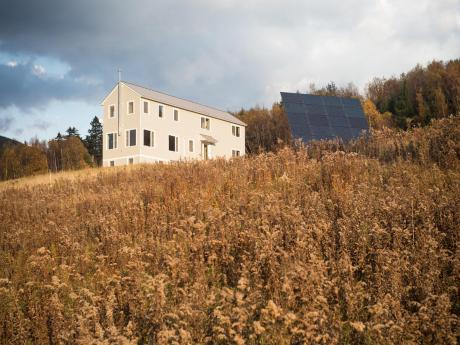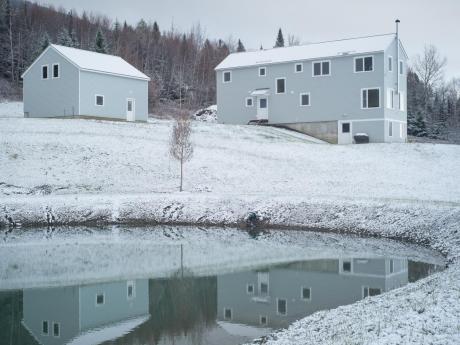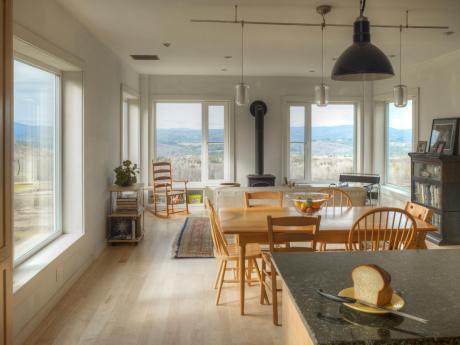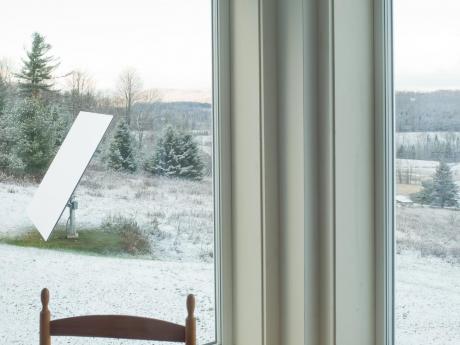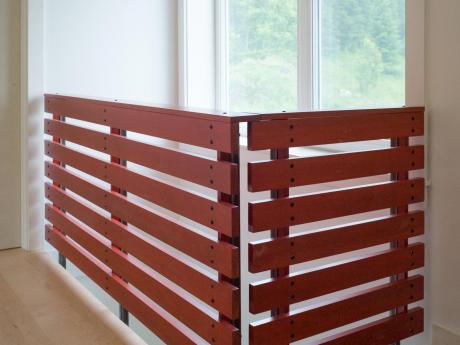Hillside Residence
Project Photo Gallery
Other Team Members
Tirey & Associates, Structural Engineers
Fritz Fay, Construction Manager
Ratings, Awards and Recognition
"Minus eighteen degrees outside, sixty-eight degrees inside, and zero ice dams!"
House Owner
This 2,400 SF four-bedroom house was designed for a growing family with a very tight budget. Construction was largely completed by the end of July of 2014.
The project is located on a 15-acre northwest sloping site in Vermont’s Northeast Kingdom. Willoughby Gap dominates the panoramic southwest-to-northwest view, and the owners wanted to see this dramatic feature from main living areas. For this reason, and because of the grades, the narrow end of the house faces northwest, and the long axis of the house follows the fall line of the hill. Locating the house high on the hill improves the views and leaves the majority of the land available for growing hay.
Meeting the budget constraints required a simple building form with a straightforward structural system. The narrow plan eliminates interior columns. Except for the minimal disruption of the stair, joists and roof trusses span the width and march down the length of the house. The simple, economical gable form is a reinterpretation of local vernacular buildings.
The house has three bedrooms and two bathrooms on the second floor, with the master suite separated from the smaller bedrooms by the stair. The small size of the children’s bedrooms is offset by the wider common play/study hall (with a view of the valley at the end). On the main level, kitchen, dining, and living are combined; beyond the stair is air study/bedroom with a possible en- suite configuration. A studio and a play/exercise area occupy the 400 SF above-grade end of the basement.
Two air-source heat pumps, one in the basement and one on the main level, heat the house. A small wood stove provides backup heat. Floor grates, salvaged from a renovation project, allow heat to move up to the second floor. All the bedrooms have provision for installing radiant ceiling panels for supplemental heat, but the owners do not think that will be necessary. An HRV provides balanced ventilation. A heat pump water heater supplies domestic hot water.
The owners are completing designed interior and exterior features of the house as time and budget allow. Salvaged stone steps and steel steps at the front and back doors respectively provide access to the main level from outside. A custom wood railing protects the second floor opening above the front door.
Quick Facts
General
| Location | East Burke, Vermont |
|---|---|
| Building Type | Single-family residence |
| Project Type | Zero Energy Ready / Near Zero Energy |
| Basis of Performance Claim | Modeled, Verified |
| Bedrooms | 4 |
| Bathrooms | 3.0 |
| Conditioned Floor Area | 2,700 sq ft |
Energy Summary
| Energy Data Type | Modeled, Verified |
|---|---|
| Renewable Energy System Type(s) | Photovoltaics |
| Ratings |
None. |
| Net electricity usage (purchased) | 2,910 kWh/year |
| Annual renewable energy generated | 8,699 kWh/year |
Envelope and Mechanicals
| Subslab assembly |
Rigid foam |
|---|---|
| Foundation wall assembly |
Concrete walls |
| Above grade wall assembly |
2x6 studs filled with blown cellulose; Zipp system sheathing taped; two 2" layers of foam, joints offset and taped; vertical strips; siding. |
| Door Assembly |
Intus PVC windows and doors, triple-glazed |
| Air Changes per hour, ACH50 | 0.40 ACH50 |

